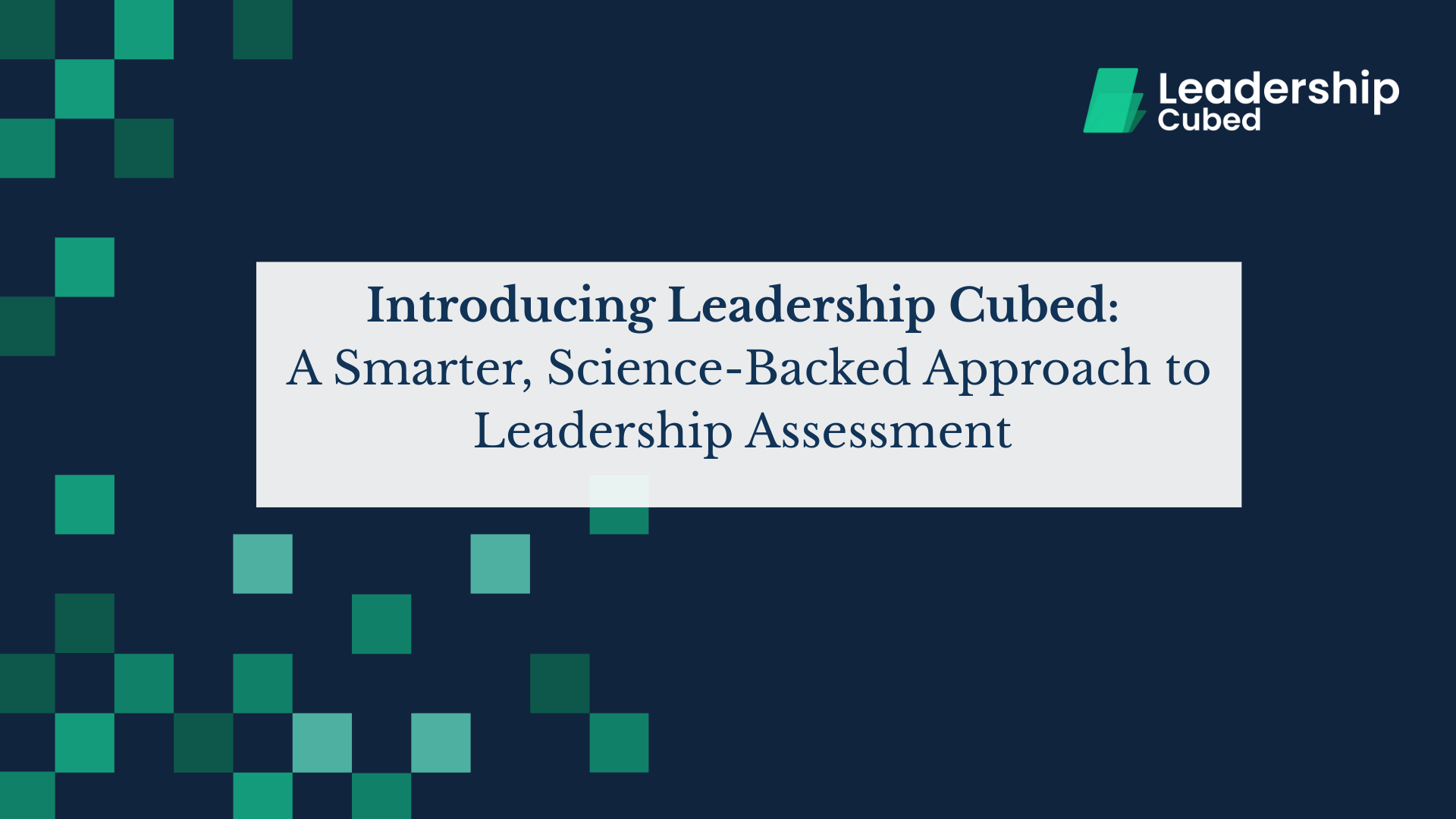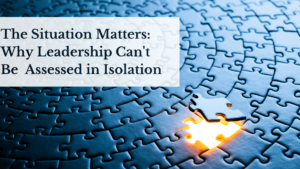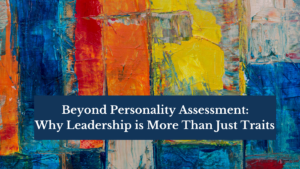What’s wrong with leadership assessment?
In this short series of articles we assert that organisations are assessing and developing leaders the wrong way. We invest massively in leadership development, yet a gap exists between our expectations of leaders and what they deliver – and part of this gap is due to poor measurement. We overemphasise the qualities of the leader, overuse personality as a proxy indicator of leadership, while downplaying essential aspects of the situation.
But leadership effectiveness is always situational. Success or failure hinges on the fit between a leader’s capabilities and the specific demands of the context – such as the organisation’s priorities, its culture, and colleagues’ skills and attitudes. Effective leadership involves reading and adapting to this situational reality.
How should we measure leadership?
To close the leadership gap, we need to measure what gets delivered, how it’s delivered, as well as key situational aspects. A good assessment tool should focus on skills, behaviours, and factors that really matter – in other words, the characteristics that are psychologically meaningful. This means building a tool based on high-quality research, linked to an underlying theory that explains how leadership is delivered.
The tool needs to have psychometric rigour – it reliably and accurately measures what it says it does. Finally, it must be practical: affordable, accessible, quick to complete, and difficult to fake.
Introducing Leadership Cubed
Kurt Lewin once said, “There’s nothing as practical as a good theory”. But with so many leadership models and research findings, which should guide our assessment design?
This key question was at the core of my DPhil, in which I researched leader effectiveness using a 360 lens, focused on behaviours. With a background in occupational psychology and psychometrics, I’ve spent my career helping organisations identify their leaders and top talent and enhance their effectiveness.
To help close this gap, I teamed up with Dr Alan Bourne, a well-known occupational psychologist and psychometrician, with a proven track record in building successful assessment organisations. Together, we created Leadership Cubed: a framework and assessment designed to measure leadership in a multi-dimensional, real-world way. The name evokes the Rubik’s Cube – reminding us that leadership has multiple sides that must align.
We started with a simple truth: leadership exists to get things done. Leaders show direction, enable change, and coordinate effort. We define leadership as a goal-focused process, in a specific context, involving people and resources to deliver outcomes.
Our challenge was to identify the core skills that enable this. We read widely on leadership, combing through the vast quantity of publications to pinpoint the vital skills for the Leadership Cubed tool. We focused on skills that:
- Are well-supported by research and practice
- Improve leadership outcomes
- Are relevant for leadership as a process, from goal-setting to delivery
- Are mutually exclusive and collectively exhaustive (MECE)
- Are easy for users to grasp and apply
We also incorporated lessons from methodologies like Agile, Lean, and Six Sigma, and decades of consulting and in-house leadership experience across sectors.
Leadership Cubed Skills
This process led us to nine core skills that underpin leadership:
Visioning & Managing Change: Creating and communicating vision, aligning teams, setting goals, tracking progress, guiding others through change. |
Influencing & Networking: Influencing without authority, building relationships, managing expectations, persuading stakeholders. |
Win-Win Delivery: Aligning with stakeholders, resolving conflicts, fostering collaboration, delivering shared goals. |
Resourcing & Supporting: Securing people and funding, allocating resources, providing guidance, enabling effective delivery. |
Empowering & Energising: Trusting teams, encouraging ownership, energising communication, recognising achievement. |
Bold Decision-Making: Confident, timely decision-making under pressure, setting priorities, role-modelling responsibility. |
Smart Problem-Solving: Combining logic and empathy, root-cause analysis, informed judgement, considering impact. |
Feedback Agility: Using feedback to adapt plans, improve performance, and adjust personal behaviour. |
Calm under Pressure: Staying focused and positive, managing crises, showing resilience, enhancing team morale. |
A tenth element, Professional & Technical Expertise, underpins the model. While not a leadership skill in itself, it provides the credibility on which leadership rests.
The nine leadership skills work in unison. Visioning, Influencing, and Win-Win Delivery set the direction, and align people and stakeholders. This sets the stage for action through Resourcing, Empowering, and Decision-Making. Finally, the adaptive skills of Problem-Solving, Feedback Agility, and Calmness under Pressure help leaders – and by extension, their teams – solve problems, navigate challenges, and nimbly respond.
Pivot #1 to the Situation: Leadership Levels
Let’s now rotate the cube to two other facets: the level at which leaders operate and the organisational culture they belong to. These aspects are crucial in understanding leadership effectiveness.
While not a topic of great research interest, in many organisations hierarchical level is an important topic – this is evidenced by job grades, descriptions, roles, responsibilities, salary levels, bonus plans, and organisational charts. Leadership behaviours change at different levels, from first-time supervisor to senior executive. The nine Leadership Cubed skills are essential at all levels, but become more sophisticated as the scope of impact and decision-making time horizon increases.
We designed Leadership Cubed to distinguish between three levels of leadership: team leader, functional leader, and senior leader, with skills becoming tougher at higher levels. Feedback reports show participants’ ratings at all three levels, linking to their current level and future potential.
Pivot #2 to the Situation: Organisational Culture
Culture is another key situational factor – one that is easy to miss because it seems so obvious. Leaders sometimes fail not from lack of skill, but from misalignment with the organisation’s norms and expectations.
We draw from Quinn & Rohrbaugh’s (1983) Competing Values Framework, a classic study that has been repeatedly tested and remains relevant (Hartnell et al., 2011). The model identified four culture types – innovation, stability, teamwork, and results – and proposed that companies balance competing demands to achieve effectiveness. Leadership Cubed includes a similar set of organisational values, again arranged as a trade-off. To this four, we’ve added two more that loom large in many leadership roles: the tension between the competing drivers of cost efficiency versus expansion.
Assessing Leaders Objectively
Leadership Cubed measures the three dimensions – skills, level, and culture – through behaviourally anchored items, arranged in scales (or clusters). The assessment is online, takes around 15 minutes, and supports the rating formats of self, 180 (self and manager), and full 360 (self, manager, peers, and direct reports).
To reduce faking, we use ipsative (forced-choice) blocks, which ask respondents to rank-order behaviours. This format increases accuracy and makes the results harder to game. All this adds up to a more objective and precise leadership assessment.
Outputs and Applications
The detailed, easy-to-read feedback report provides:
- Scores across the nine skills
- Insights by leadership level: team leaders, functional leaders, senior leader
- A cultural profile
- Hidden strengths and blind spots
- Development tips tailored to each profile
It’s more than a 360: it helps leaders understand their current impact, adapt to their environment, and grow their potential. Whatever a leader’s current levels of performance on the skills – from underdeveloped to very strong – Leadership Cubed shows the way to get even better.
Future of Leadership Cubed
Currently, we’re running a multi-organisation trial of Leadership Cubed, involving leaders across industry sectors. Once complete, we will analyse psychometric properties (e.g. reliability, factor structure), establish norms, and apply for British Psychological Society registration.
The ultimate goal is for Leadership Cubed to help transform how leaders are assessed and developed, closing the leadership gap. We want to make leadership assessment more precise, contextual, and developmental. With better insights, organisations can target development and spend more effectively, and leaders can deliver greater impact for employees, customers, and society as a whole.
Questions for Reflection
Approaches to leadership development vary widely across organisations. These questions are designed to help you reflect critically on how you’re currently driving leadership performance:
- What does your current leadership assessment actually measure – behaviour, outcomes, or personality traits?
- Are your development programmes tailored to leadership level and organisational context, or built on generic models?
- Do your assessment tools give leaders practical insights they can act on, or just data points to review?
- How well do your current methods capture a leader’s ability to adapt to your organisation’s culture and values?
- Are situational factors such as leadership level and business context accounted for in how you evaluate leaders?
- What opportunities exist to bring more rigour, relevance, and real-world focus into your leadership development approach?
Get involved
Would your organisation like to be part of the Leadership Cubed trial study? It’s a fantastic opportunity to experience this innovative tool, get a reading on your company’s leaders, and help them develop. It will also give you a voice in the design of this exciting new tool. Feel free to reach out to get in touch.
Quinn, R. E. and J. Rohrbaugh. (1983). A Spatial Model of Effectiveness Criteria: Towards a Competing Values. Approach to Organizational Analysis. Management science, 29(3), 363-377.
Hartnell, C.A., Ou, A.Y. and Kinicki, A., 2011. Organizational culture and organizational effectiveness: a meta-analytic investigation of the competing values framework’s theoretical suppositions. Journal of applied psychology, 96(4), p.677.
Lewin, K. (1952). Field theory in social science: Selected theoretical papers by Kurt Lewin. London: Tavistock




